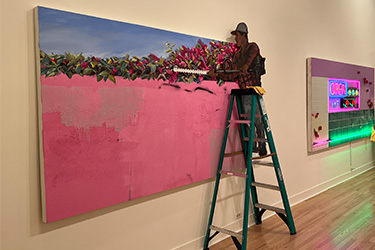University of Richmond Custodial Staff Contribute to Latest Museum Exhibition Highlighting the Immigrant Workforce
UNIVERSITY OF RICHMOND — Custodial services staff at the University of Richmond played a key role in the latest museum exhibition, and their involvement had nothing to do with keeping the space beautiful.
The Department of Latin American, Latino & Iberian Studies and University Museums asked custodial staff for their input on an exhibition by Latinx artist Jay Lynn Gomez focusing on the value of domestic workers. Staff shared their impressions on the art and its layout, and provided comments and opinions that were integrated into the exhibition’s educational initiatives, catalogue, and informational panels.
“Collaborating with facilities employees offered an opportunity for talking about the vital energy involved in a work that implies much more than keeping up cleanliness and beauty of physical spaces, and for exploring the meanings of work and working time,” said exhibition co-curator Karina Vázquez, director of UR’s Spanish Community-Based Learning Program.
 Jay Lynn Gomez: Domestic Scenes Reconsidered is on view in the Harnett Museum of Art through April 21. Gomez’ art focuses on the “invisible” labor of care-taking, housekeeping, and landscaping reflecting on the immigrant workforce in the U.S. and its stereotypical representations in visual culture.
Jay Lynn Gomez: Domestic Scenes Reconsidered is on view in the Harnett Museum of Art through April 21. Gomez’ art focuses on the “invisible” labor of care-taking, housekeeping, and landscaping reflecting on the immigrant workforce in the U.S. and its stereotypical representations in visual culture.
Gomez was born in 1986 in San Bernardino, California to undocumented Mexican immigrant parents who have since become U.S. citizens. She briefly attended the California Institute for the Arts before leaving to work as a live-in nanny, an experience that informed her subsequent artistic practice.
Gomez’s work is known for addressing issues of immigration and showing a different perspective on labor forces that keep our homes, yards, and pools in pristine condition. Her artwork has been shown at the Smithsonian National Portrait Gallery and Museum of Latin American Art
“Gomez’ art is an educational tool to better understand social reality,” said Vázquez. “Her canvases are an invitation to reflect on the societal meanings of love/care, domesticity, and work.”
###
